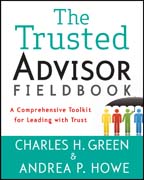
The trusted advisor fieldbook: a comprehensive toolkit for leading with trust
Green, Charles H.
Howe, Andrea P.
A practical guide to being a trusted advisor for leaders in any industry In this hands-on addition to the popular book The Trusted Advisor, you'll find answers to pervasive questions about trust and leadership--such as how to developbusiness with trust, nurture trust-based relationships, build and run a trustworthy organization, and develop your trust skill set. This pragmatic workbookdelivers everyday tools, exercises, resources, and actionable to-do lists forthe wide range of situations a trusted advisor inevitably encounters. The authors speak in concrete terms about how to dramatically improve your results insales, relationship management, and organizational performance.Your success as a leader will always be based on the degree to which you are trusted by yourstakeholders. Each chapter offers specific ways to train your thinking and your habits in order to earn the trust that is necessary to be influential, successful, and known as someone who makes a difference. Self-administered worksheets and coaching questions provide immediate insights into your current business challenges Real-life examples demonstrate proven ways to 'walk the talk' Quizzes test your readiness to apply what you have learned Action plans bridge the gap between insights and outcomes Put the knowledge and practices in this fieldbook to work, and you'll be someone who earns trust quickly, consistently,and sustainably--in business and in life. ÍNDICE: Introduction Why a Fieldbook Who Should Read this Book How to Use this Book Where to Begin I: A Trust Primer Chapter 1: Fundamental Truths Fundamental Truth 1: Trust Requires Trusting and Being Trusted Fundamental Truth 2:Trust is Personal Fundamental Truth 3: Trust is About Relationships Fundamental Truth 4: Trust is Created in Interactions Fundamental Truth 5: There Is No Trust Without Risk Fundamental Truth 6: Trust is Paradoxical Fundamental Truth7: Listening Drives Trust and Influence Fundamental Truth 8: Trust Does Not Take Time Fundamental Truth 9: Trust is Strong and Durable, not Fragile Fundamental Truth 10: You Get What You Give Chapter 2: Fundamental Attitudes Fundamental Attitude 1: Principles over Processes Fundamental Attitude 2: You Are MoreConnected Than You Think Fundamental Attitude 3: It's Not About You Fundamental Attitude 4: Curiosity Trumps Knowing Fundamental Attitude 5: Time Works forYou Chapter 3: The Dynamics of Influence Earning the Right to Be Right: ThreeSteps A Five-Point Checklist for Influencing Meetings Chapter 4: Three Trust Models Trust Model #1: The Trust Equation Trust Model #2: The Trust Creation Process Trust Model #3: The Trust Principles Chapter 5: Five Trust Skills Listen Partner Improvise Risk Know Yourself II: Developing Your Trust Skill Set Chapter 6: Listen The Listening Differentiator: Empathy Four Barriers to Paying Attention Three-Level Listening Seven Listening Best Practices Your Everyday Empathy Workout: Low Weights, High Reps Chapter 7: Partner Partnering Traits TenCommon Partnering Barriers Self-Assessment: Are You Primed for Partnership? Specific Ways to Build Your Partnering Muscle Chapter 8: Improvise The Science behind Moments of Truth How Moments of Truth become Moments of Mastery The Practice of Improvisation Role-Play Your Way to Mastery Chapter 9: Risk The Relationship between Trust and Risk Six Ways to Practice Risk-Taking The Three-Question Transparency Test A Tool for Truth-Telling: Name It and Claim It The Power of Caveats Chapter 10: Know Yourself How Blind Spots Impede Trust-Building Three Approaches to Expand Your Self-Knowledge How to Use Self-Awareness to Increase Trust III: Developing Business with Trust Chapter 11: Trust-Based Marketing and Business Development Focus on Your Customer Collaborate to Drive New Business Focus on Relationships, not Transactions Be Transparent with Prospectsand Clients Chapter 12: Trust-Based Networking Ten Best Practices for Trust-Based Networking Technology and Trust-Based Networking Chapter 13: Delivering the Pitch 1. Sometimes the Best Pitch is No Pitch 2. Don't Skip the Pre-Pitch Warm-Up 3. Make It Interactive 4. Have a Point of View 5. Take the Pre-Occupation Out of Price 6. With PowerPoint, Less is More 7. Stop Selling Your Qualifications 8. Do Not Denigrate the Competition 9. Be Willing to Ditch the Pitch Chapter 14: Handling Objections The Problem: How You Think About Objections The Antidote: Change Your Thinking Three Ways To
- ISBN: 978-1-118-08564-6
- Editorial: John Wiley & Sons
- Encuadernacion: Rústica
- Páginas: 288
- Fecha Publicación: 26/10/2011
- Nº Volúmenes: 1
- Idioma: Inglés
